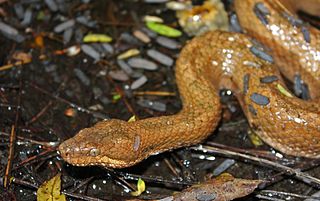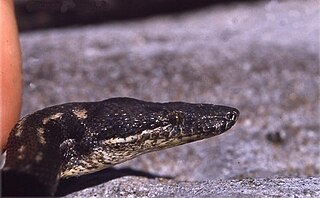
Boa is a genus of boas found in Mexico, the Caribbean, and Central and South America. Five extant species, and one extinct, are currently recognized.

Aspidites is a genus of pythons endemic to Australia. The name can be translated as "shield bearer" and pertains to the symmetrically shaped head scales. Currently, two species are recognized.

The Acrochordidae, commonly known as wart snakes, Java wart snakes, file snakes, elephant trunk snakes, or dogface snakes are a monogeneric family created for the genus Acrochordus. This is a group of basal aquatic snakes found in Australia and tropical Asia. Currently, three species are recognized.

The Typhlopidae are a family of blind snakes. They are found mostly in the tropical regions of Africa, Asia, the Americas, and all mainland Australia and various islands. The rostral scale overhangs the mouth to form a shovel-like burrowing structure. They live underground in burrows, and since they have no use for vision, their eyes are mostly vestigial. They have light-detecting black eye spots, and teeth occur in the upper jaw. Typhlopids do not have dislocatable lower jaw articulations restricting them to prey smaller than their oral aperture. All species in the family Typhlopidae are fossorial and feed on social fossorial invertebrates such as termites and ants. The tracheal lung is present and chambered in all species. One species, the Brahminy's blind snake, is the only unisexual snake, with the entire population being female and reproducing via parthenogenesis. The tail ends with a horn-like scale. Most of these species are oviparous. Currently, 18 genera are recognized containing over 200 species.

The Anomalepididae are a family of nonvenomous snakes, native to Central and South America. They are similar to Typhlopidae, except that some species possess a single tooth in the lower jaw. Currently, four genera and 15 species are recognized. Common names include primitive blind snake and dawn blind snake.

The Leptotyphlopidae are a family of snakes found in North America, South America, Africa and Asia. All are fossorial and adapted to burrowing, feeding on ants and termites. Two subfamilies are recognized.

Xenopeltis, the sunbeam snakes, are the sole genus of the monotypic family Xenopeltidae, the species of which are found in Southeast Asia. Sunbeam snakes are known for their highly iridescent scales. Three species are recognized, each one with no subspecies. Studies of DNA suggest that the xenopeltids are most closely related to the Mexican burrowing python and to the true pythons (Pythonidae).

The Tropidophiidae, common name dwarf boas or thunder snakes, are a family of nonvenomous snakes found from Mexico and the West Indies south to southeastern Brazil. These are small to medium-sized fossorial snakes, some with beautiful and striking color patterns. Currently, two living genera, containing 34 species, are recognized. Two other genera were once considered to be tropidophiids but are now known to be more closely related to the boids, and are classified in the subfamily Ungaliophiinae. There are a relatively large number of fossil snakes that have been described as tropidophiids, but which of these are more closely related to Tropidophis and Trachyboa and which are more closely related to Ungaliophis and Exiliboa is unknown.
The Christmas Island blind snake is a species of snake in the family Typhlopidae. The species is endemic to Christmas Island. There are no subspecies that are recognized as being valid.
Uropeltis is a genus of nonvenomous shield tail snakes endemic to Peninsular India. As of 2022, 26 species are recognized as being valid.
Rhinoleptus koniagui, also known commonly as Villiers's blind snake, is a species of snake in the family Leptotyphlopidae. The species, which is indigenous to West Africa, is monotypic in the genus Rhinoleptus. It is among the smallest snakes in the world. There are no subspecies that are recognized as being valid.

Typhlops is a genus of blind snakes in the family Typhlopidae. The genus is endemic to the West Indies. Some species which were formerly placed in the genus Typhlops have been moved to the genera Afrotyphlops, Amerotyphlops, Anilios, Antillotyphlops, Argyrophis, Cubatyphlops, Indotyphlops, Letheobia, Madatyphlops, Malayotyphlops, and Xerotyphlops.

The Round Island burrowing boa is an extinct species of snake, in the monotypic genus Bolyeria, in the family Bolyeriidae. The species, which was endemic to Mauritius, was last seen on Round Island in 1975. There are no recognized subspecies.

Tropidophis, common name Caribbean dwarf boas, wood snakes or West Indian wood snakes, is a genus of dwarf boas endemic to the West Indies and South America. Currently, either 17 or 33 species are recognized, depending on the authority.

The Round Island boa, also known commonly as the Round Island keel-scaled boa and the Round Island ground boa, is a species of nonvenomous snake in the monotypic genus Casarea in the family Bolyeriidae. The species is endemic to Round Island, Mauritius. No subspecies are currently recognized.

Rhinotyphlops is a genus of blind snakes in the family Typhlopidae. The genus is found in Africa, the Middle East, and India. Some species formerly assigned to the genus Rhinotyphlops have been moved to the genera Afrotyphlops and Letheobia.
Helminthophis is a genus of non-venomous blind snakes found in southern Central America and northwestern South America. Currently, 3 monotypic species are recognized.

Typhlophis is a monotypic genus created for the blind snake species, Typhlophis squamosus, found along the Atlantic coast of South America from the Guianas to Pará in Brazil, as well as in Trinidad. No subspecies are currently recognized.
Cyclotyphlops deharvengi, or Deharveng’s blind snake, is a species of blind snake placed in the monotypic genus Cyclotyphlops. It is found in southeastern Sulawesi, Indonesia. No subspecies are currently recognized.
Xenophidion is a genus of snakes first described in 1995, and the only genus of the monotypic family Xenophidiidae. Commonly referred to as spinejaw snakes, this genus is found in Borneo and peninsular Malaysia.













